

 |
||
 |
||
 |
||||||||||||||||||||||||||
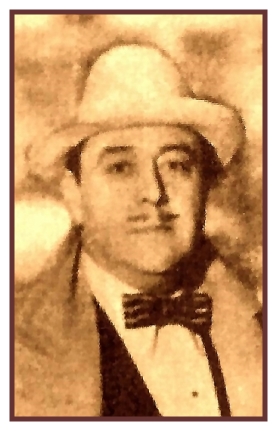 |
||||||||||||||||||||||||||
 |
||||||||||||||||||||||||||
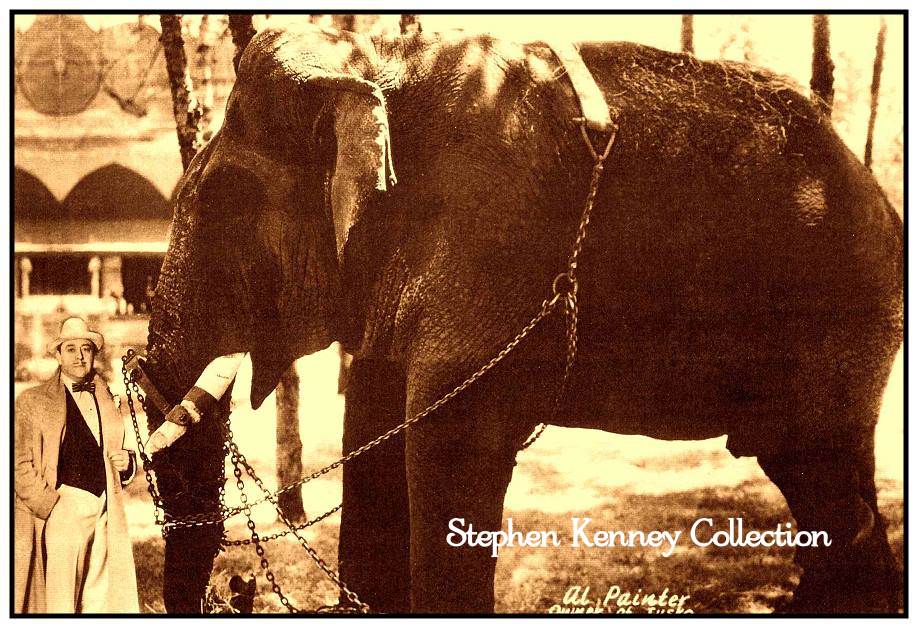 |
||||||||||||||||||||||||||
|
Al Painter at Lotus Isle with Tusko the Magnificent in Portland in 1931. |
||||||||||||||||||||||||||
|
The first major Dance Marathon in the Northwest was held at Lotus Isle Amusement Park in 1931 in Portland. Two other walkathons were held in Portland that year and all three were involved in legal controversies regarding the hiring of contestants who were expected to endure long hours and there were allegations that women or children were subjected to discriminatory practices. The crowds flocked to Lotus Isle to see fifty-six couples who competed in an endurance contest that continued for several months. Walkathon Fever had a very positive impact on profits from radio advertising and walkathon promotions. Teams of two contestants could win thousands of dollars in cash and prizes. There are newspaper accounts of Al Painter’s Walkathon Organization leaving a trail of debts from Oregon to Arkansas, as well as Louisiana and Pennsylvania. The subject of missing prize money was usually noted, meaning that the people who earned the prize money didn’t always receive it. |
||||||||||||||||||||||||||
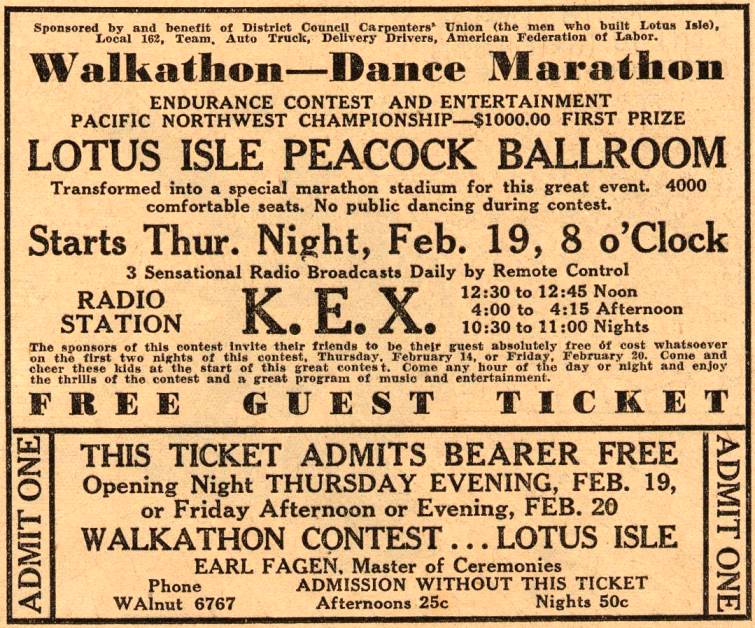 |
||||||||||||||||||||||||||
|
Advertisement for opening night for Portland’s first Walkathon on February 19, 1931 which included a pass for free admission. |
||||||||||||||||||||||||||
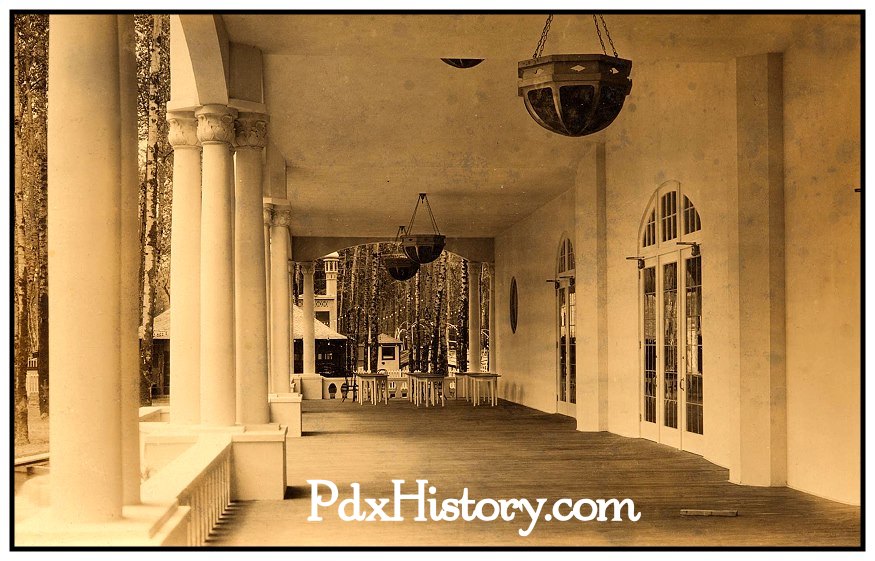 |
||||||||||||||||||||||||||
|
The Peacock Ballroom at Lotus Isle, which is thought to be the birthplace of the dance marathon circuit, was very popular. |
||||||||||||||||||||||||||
|
Evening dances held sway at the Peacock Ballroom at Lotus Isle from 9:00 pm to midnight. You could dance to the orchestras of Don DeForest, Archie Loveland, Bill Darby, Sam Herman, Frank Kenin or Herman Kenin among others, and enjoy the stellar entertainer and banjoist Monte Ballou. Couples at the walkathons would see how long they could dance continuously, sometimes for several days at a time, taking a ten-minute break every hour. A state certified nurse was required at all such events. Some of the organizers from Portland went on to fame and fortune in larger cities including: Walter Tebbetts, who owned several Portland theatres including the very ornate Oriental Theatre, and Leo Seltzer, who went on to start Roller Derby in later years. Painter is credited with first introducing vaudeville into the dance marathon performance at Lotus Isle on Tomahawk Island, east of Jantzen Beach and Hayden Island. |
||||||||||||||||||||||||||
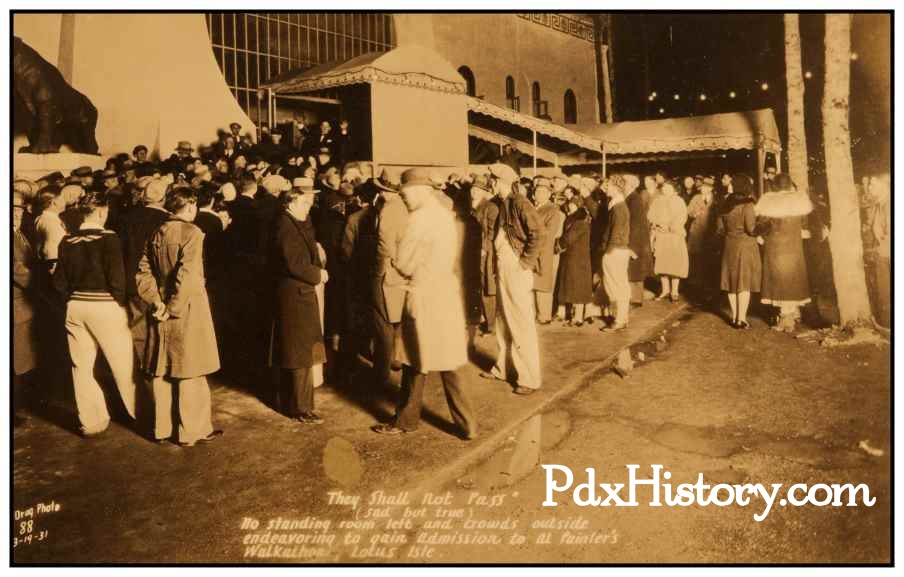 |
||||||||||||||||||||||||||
|
Couples would compete in Walkathons at the magnificent Peacock Ballroom for thousands in cash and prizes. Patrons would pack the ballroom in the evenings where at least 6,600 people joined the festivities and many more lined up outside to get in. |
||||||||||||||||||||||||||
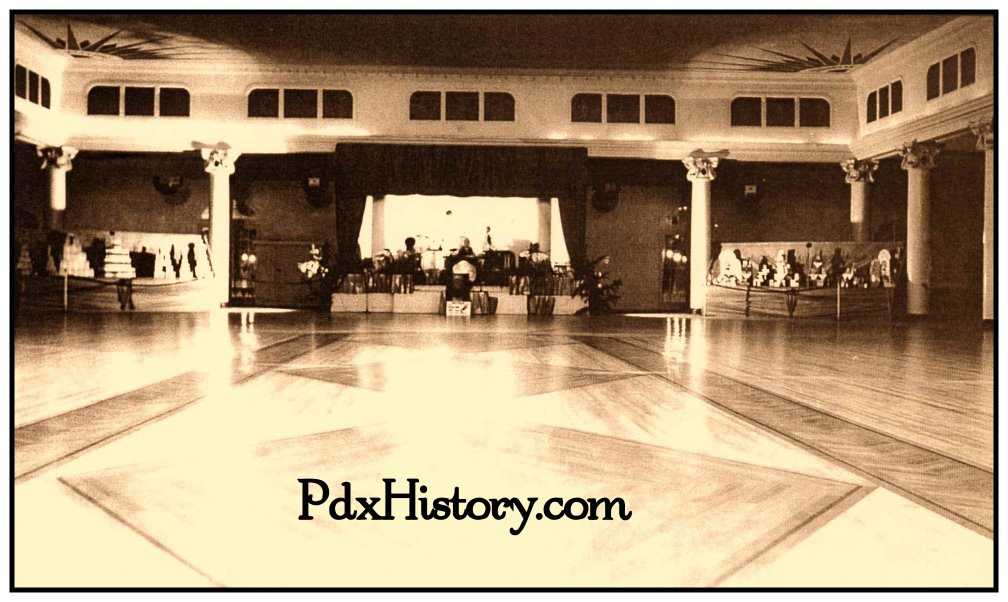 |
||||
|
|
||||
|
Interior view of the Peacock Ballroom in August 1931 during the General Mills “Jello Week,” August 1-9, 1931, just days before it would burn to the ground. |
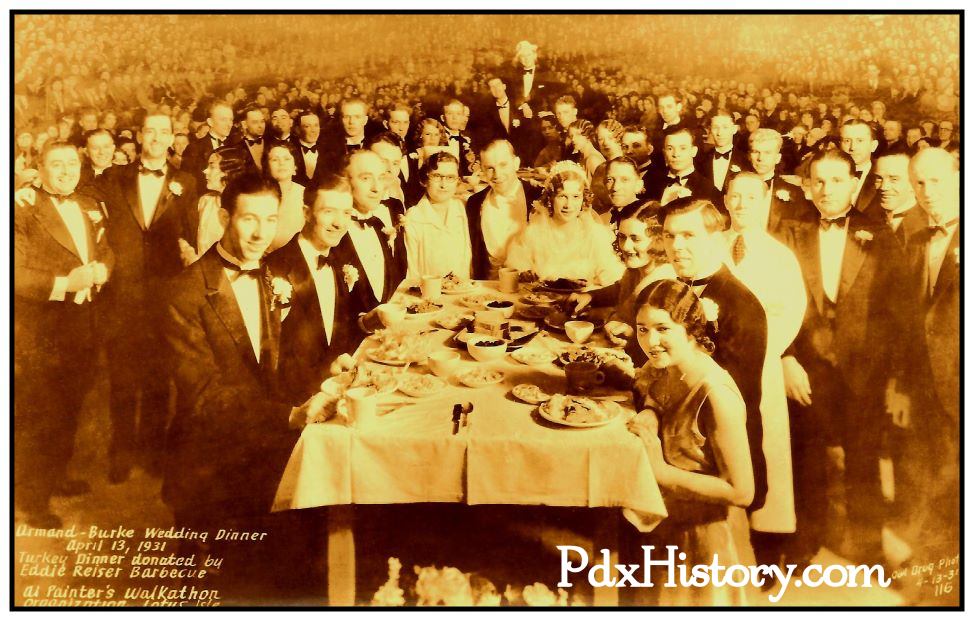 |
|
Several faux weddings were held in the Peacock Ballroom. |
|
|
||||||||||||||||||||
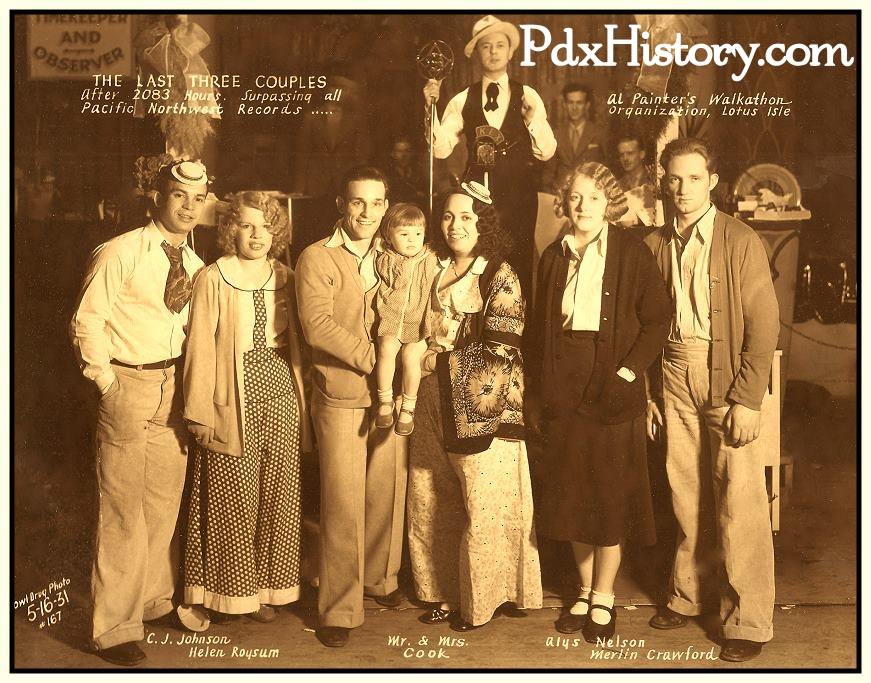 |
|
The three remaining couples at Al Painter’s Walkathon at Lotus Isle in Portland in 1931. |
|
|
||||||||||||||||||||||||||||||||||||||||||||||||||||||||||||||||||||||||||||||||||||||||||||||||||||||||||||||||||||||||||||||||||||||||
|
From an Entertainment Column written by Arnold Marks at the Oregon Journal on April 24, 1970, we can get a glimpse of Al Painter and what he was like. Marks got firsthand information about Al Painter from Portland costumer Al Learman, who knew Painter well. Learman provided costumes for Painter for the weddings, old-fashioned nights and other events that were staged to entertain Depression-era fans at the Peacock Ballroom. Learman was a teenager in the 1920s when he first met the Englishman Painter, when he traveled to the Grand Hotel in Vienna, Austria with his parents who owned the Chicago Costume House in Portland and provided costumes to theaters up and down the Coast. It was in Vienna where the Learmans became acquainted with Painter who operated a skating rink. The next time Learman saw Painter was several years later in Portland when he was hired to make costumes for him. In the 1880s, Ellen Learman worked as a wardrobe mistress at the Marquam Grand Theatre where she made dresses for stars such as Sarah Bernhardt and Lillian Russell. After a divorce from her first husband, Ellen married Fred Wonder in 1888. They opened the Wonder Costume House in 1890 at 388 Morrison Street. The shop would later become the Chicago Costume House. Ellen’s son from her first marriage, Tommy Learman, worked in the shop and married one of his co-workers, Lillian Benjamin in 1910. Their son, Al Learman, was born in 1911. Several years later they moved to California where young Al appeared in several silent films including Tom Sawyer and Penrod and Son. In the 1920s, the Learman family and Grandma Wonder moved back to Portland and rechristened their business the Chicago Costume House. Al Learman had just graduated from high school a year or so before making costumes at Lotus Isle. In 1936, he met and married Helen Brickman who became the namesake for their business that was rechristened Helen’s Pacific Costumers, the famous costume shop which began as the Wonder Costume House in 1890 and just closed its doors on August 31, 2017. In 1970, Oregon Journal Columnist Arnold Marks asked Al Learman to describe Al Painter who said that Painter was a “swinger of his day, a fast-talking showman.” He went on to say that “Painter was a big man who looked much like Warner Oland who played Charlie Chan.” After the marathon fizzled, Painter disappeared from Portland, leaving a trail of unpaid debts. The next time that Learman saw Painter was in San Francisco during the Treasure Island World’s Fair of 1939-40. The costumer was a guest of Harry Shipstad of the Portland Ice Arena on NW Marshall Street at a Shipstad and Johnson Ice Follies performance in the old Dreamland arena. Learman recalled that ”we recognized Painter by his high voice. The promoter was with the lieutenant governor of California. He saw us and came up to me and asked for $20 to entertain the politician.” Continuing, Learman revealed that “Painter was the kind of man who made millions, but never kept a cent. He was a great guy, it was easy come, easy go with him, Painter was brilliant and well-read, but a dreamer who would reach for the moon and lose hold of a handful of stars. He spread his money around. At the World’s Fair, Painter had an old sailing vessel docked at Fisherman’s Wharf outfitted like a museum. It attracted tourists like flies.” Learman recalled that Painter died shortly after the fair ended. The walkathon at Lotus Isle was closed to the public and no spectators were allowed to enter after midnight on Monday, June 1, 1931, however, the contestants, four men and four women, refused to stop. The Painter organization attempted to close up the walkathon by offering $250 to each of the remaining eight contestants. The contestants refused the offer and continued trudging around the ballroom in hopes that one of the four couples would be declared the winners to receive the promised $2,000 prize. The public was allowed to return on Tuesday evening and an arrest warrant was issued for Painter. On June 3, Painter turned himself in to authorities and he was charged with employing women for unreasonably long hours in violation of labor laws. Painter ended up paying a fine of $100 and the charges were dropped after the schedule of the walkathon was revised and the walkathon was declared in compliance with the law. The revised rules, which stated that women could work for 12 hours and rest for 12 hours, did not apply to the men who were contestants. The men continued as contestants without any rest periods. Earl Fagan announced that two or three women contestants could be assigned to each male contestant to comply with these changes. No further mention was made of the actual ending of the walkathon and it is assumed each of the eight final contestants took home $250 in prize money. After leaving Portland in 1931, Painter was seen later that year promoting another walkathon in New Orleans which opened on November 10. After stirring up local controversy again, Painter left New Orleans in a dispute after declaring himself the winner of the walkathon twelve days later, despite not having been an original contestant. In his wake, he left a trail of bad checks and unpaid bills. The walkathon ended the following day when the seven remaining couples stopped the walkathon and left weary and heartbroken. According to Billboard Magazine, Al Painter was managing the Fox Valley Walkathon in Aurora, Illinois in May 1934. One of his emcees was Mickey Thayer who conducted a combination of treadmills, derbies and hot shots which created so much public interest that admission was increased from 25 cents to 40 cents. |
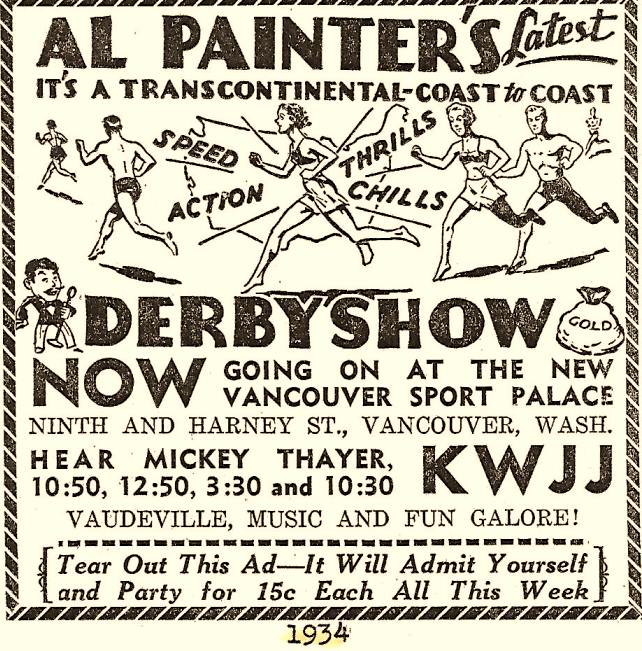 |
|||
|
Also in 1934, Al Painter brought his transcontinental Derby Show to the Vancouver Sports Palace at 9th and Harney streets in Vancouver, Washington. Mickey Thayer was employed as an emcee. |
|||
|
Billboard Magazine reported that Al Painter had been hired to handle publicity for the Mishkind Secaucus Walkathon in Secaucus, New Jersey in June 1935. Earl Fagan was the head emcee. Another walkathon, the 1932 ”Hurricane Model,” billed as nine times faster than any other walkathon, was held at Lotus Isle in the Grand Ballroom from March to May 1932. Ted Mullen was advertised as the chief emcee along with assistant emcees Eddie Cotton, Chief Nut and Clown Quince. Doug Angus, matinee idol, was billed as an entertainer. According to promotional material, ”Ted Mullen, our Chief Master of Ceremonies has been describing to you the terrific after-effects of those derbies, figure-eights, treadmills and whirlwinds.” On Sunday, May 9, 1932, there were four couples still pounding the boards after 1,245 hours. |
|
|
|||||||||||||||||||||||
|
Earl Mossman spent many years traveling the country's vaudeville circuit, first dancing and later with all-girl chorus lines. During his heyday as an entertainer, New York agents had Earl Mossman on bills with Al Jolson, Jack Benny and Eddie Cantor. In 1931, Mossman returned to Portland with his Broadway dance partner Ray Vance and they entertained at Al Painter’s Walkathon at Lotus Isle. Mossman remembered Painter and his big Packard limousine which was driven by a uniformed midget chauffeur. He recalled the silver-plated bulldog hood ornament and the silver initials “A. P.” gleaming on the chrome radiator grille. Mossman revealed, ”During those Prohibition days, the showman staged lavish parties in his hotel suite, garbed stylishly in Chinese silk robes. Painter was known for sipping buttermilk and amazing his friends by making long distance calls to cities up and down the Coast to start more walkathons.” However, Mossman also had a sad memory of those marathon-walkathon days. Mossman and his partner Ray Vance who was from Vancouver, Washington, had returned from New York and were in Portland en route to Hollywood with a film contract. Vance had been visiting his family in Vancouver and headed back to Portland about midnight to talk to Painter, he told his driver to let him out near the Lotus Isle Amusement Park entrance. After midnight the doors to the walkathon were locked and no one could enter until the next day. However, patrons at the Peacock Ballroom were allowed to leave at any time. The driver tried to dissuade Vance from getting out of the car. He countered ”Marathons run 24 hours,” and he got out of the car. He was not seen again until three months later when his headless body was found near the Columbia River below the adjacent, old Columbia Beach Park. The death was presumed to be a murder and it was never solved. |
 |